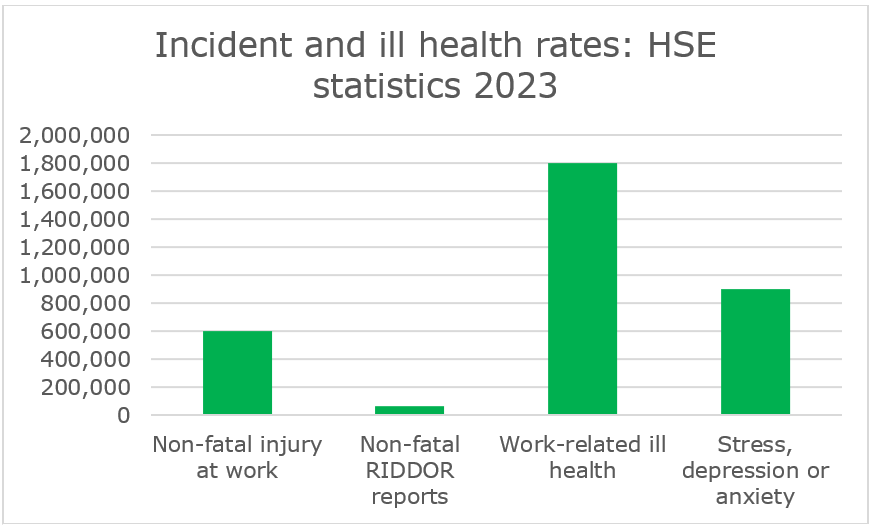Safety practitioners across the globe are familiar with ISO 45003 (psychological health and safety at work), but Western Australia’s WorkSafe has published an in depth code of practice focusing on practical steps to achieve mandatory compliance with the law – the team at Eversheds Sutherland consider the lessons that can be learned from Australia’s approach.
The introduction of Australia’s Code of Practice for Psychosocial Hazards in the Workplace (“the Code”) sets a benchmark for managing psychosocial risk.
Psychosocial hazards are factors related to the interaction between work, the environment and individual wellbeing which can lead to harm – they have gained and continue to gain significant attention globally with the publication of ISO 45003 back in 2021 putting a spotlight on psychological wellbeing in the health and safety arena.
Historically, our focus as safety practitioners has concentrated on preventing people from physical injury – whether that is adding guards to a piece of machinery so a worker’s hand can’t be trapped, issuing training on the use of harnesses to people who are working at height or carrying out a workplace assessment for desk-based workers.
Of course the physical wellbeing of our people remains a priority, but when we look at the statistics, the overwhelming frontrunner as the cause of workplace illness is stress, depression or anxiety with approximately 900,000 cases in the UK last year (that’s half of all reported work-related ill health).
So what does that mean for organisations? It’s estimated work-related ill health/non-fatal workplace injury costs UK employers £20.7 billion per year, losing 35.2 million working days, so the stark financial reality is obvious, but fostering a workplace which puts its people at its core is fundamental for any business wanting to achieve long term and sustained success.
 So what can we learn from the Australian approach?
So what can we learn from the Australian approach?
The Code is a comprehensive guide, outlining practical steps for the implementation of risk management processes for psychosocial hazards. It identifies 20 commonly identified risk factors such as fatigue, burnout, isolated work, low recognition and reward, inadequate support and trauma.
Whilst the Code provides helpful advice and suggestions, it also sets out mandatory requirements for all employers (in Western Australia) which means non-compliance can result in criminal sanctions (up to $3 million (AUD) for corporates and up to $600,000 for individuals and/or 5 years imprisonment). It is a requirement under Australian legislation for a risk management approach to be used to manage any hazard in the workplace, which extends to psychological hazards.
 The 4 step risk management process is akin to the Plan Do Check Act model (HSG65) which so many of us are familiar with, but it provides practical guidance specific to psychosocial hazards. The requirements go beyond a simple stress risk assessment (now a mandatory requirement under UK law) to identify and understand foreseeable psychosocial hazards by undertaking an in depth review of the wider organisation and the specific psychological hazards that each worker or task can present.
The 4 step risk management process is akin to the Plan Do Check Act model (HSG65) which so many of us are familiar with, but it provides practical guidance specific to psychosocial hazards. The requirements go beyond a simple stress risk assessment (now a mandatory requirement under UK law) to identify and understand foreseeable psychosocial hazards by undertaking an in depth review of the wider organisation and the specific psychological hazards that each worker or task can present.
In guiding employers on the management and prevention of psychosocial hazards, the Code sets out 6 key areas:
- Leadership and workplace culture – visible leadership commitment, providing practical support including access to health management providers, willingness to listen, not adopting a punitive approach to issues raised, modelling desired behaviours, promoting a positive culture and positive team dynamics
- Workplace behaviours – maintaining a positive culture, visible leadership commitment, supportive work practices, modelling appropriate behaviours by leadership, fair and consistent implementation of policies/procedures, regular training
- Good work design – define job roles seeking regular feedback, provide training and resources to carry out roles safely and effectively, review and monitor workloads, effective communication throughout any changes
- Safe systems of work – implementing rules, policies, procedures and work practices which might include things like task rotation, rest and recovery, consideration of working hours and shift patterns
- Communication and consultation – encouraging communication and feedback and carrying out consultations. This may be encouraged through responsiveness to reports, providing opportunities for feedback both formally and informally, maintaining confidentiality and empowering a safe learning culture
- Information and training – providing information on tasks and the psychosocial hazards associated with the task, control measures and how to report if a problem arises
Permeating across each of these management and prevention measures is a focus on workplace culture and psychological safety, a subject which Eversheds Sutherland’s EHS team has a keen interest in and has written about in other publications. Psychological safety is a key component in achieving a positive and successful workplace culture, not least because it encourages open communication and feedback, but because psychologically safe workplaces promote positive social norms within teams and recognise the individuality of workers – something which psychosocial risk management must do to be effective.
The Australian Code of Practice encourages empathetic leadership—where managers actively support employees’ mental health. It also emphasizes continuous improvement through regular reviews and investigations. By fostering a culture of care and learning, organizations can create safer, healthier workplaces.
We recommend safety practitioners in all locations review the Code to consider its use and to gain more insight into Australia’s approach to psychosocial hazards.
For more information on psychosocial hazards in the workplace and the Code contact Paul Verrico, Sarah Valentine or Sophie Parkin.
Further reading
The Safety Conversation Podcast: Listen now!
The Safety Conversation with SHP (previously the Safety and Health Podcast) aims to bring you the latest news, insights and legislation updates in the form of interviews, discussions and panel debates from leading figures within the profession.
Find us on Apple Podcasts, Spotify and Google Podcasts, subscribe and join the conversation today!

 So what can we learn from the Australian approach?
So what can we learn from the Australian approach? The 4 step risk management process is akin to the Plan Do Check Act model (HSG65) which so many of us are familiar with, but it provides practical guidance specific to psychosocial hazards. The requirements go beyond a simple stress risk assessment (now a mandatory requirement under UK law) to identify and understand foreseeable psychosocial hazards by undertaking an in depth review of the wider organisation and the specific psychological hazards that each worker or task can present.
The 4 step risk management process is akin to the Plan Do Check Act model (HSG65) which so many of us are familiar with, but it provides practical guidance specific to psychosocial hazards. The requirements go beyond a simple stress risk assessment (now a mandatory requirement under UK law) to identify and understand foreseeable psychosocial hazards by undertaking an in depth review of the wider organisation and the specific psychological hazards that each worker or task can present.